Jagannath University in Bangladesh has been organizing small to large-scale awareness campaigns to motivate and enlighten school students, teachers, and the local community about the importance of conserving migratory birds and their habitats, threats to migratory birds and their ecological importance. One of them is celebrating World Migratory Bird Day. We celebrated World Migratory Bird Day (WMBD) on an earlier date this year to ensure a large number of participants due to a long government holiday in Bangladesh and the closure of all schools. On 6 October 2022, Jagannath University organized two World Migratory Bird Day events at two local schools, Bandartila Bazar Government Primary School and Madinatul Ulum Halimiah Madrasah, Nijhum Dweep National Park in Bangladesh, with financial support from the East Asian-Australasian Flyway Partnership (EAAFP). A total of 205 students of different classes, 10 local community people, five teachers, two university students and one researcher were joined the events, and most of participants are school students at Nijhum Dweep National Park.
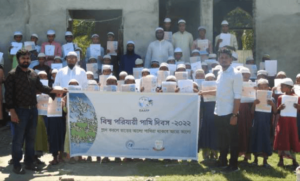 Participants, guests, and facilitators from WMBD 2022 at Madinatul Ulum Halimiah Madrasah ©️ Jagganath University |
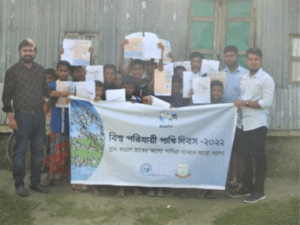 Group Photo taken at Bandartila Bazar Government Primary School ©️ Jagganath University |
Inaugural Session
Naim Khandakar, organizer of WMBD, on behalf of Jagannath University, welcomed all guests and participants. He provided a brief overview of celebrating WMBD, and the ground rules for respectful and inclusive discussions. For introductions, guests, and participants recounted memorable encounter with migratory birds. Participants were shown a documentary video titled “Migratory Birds of Nijhum Island National Park, Bangladesh.”
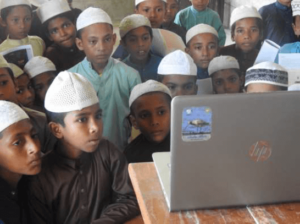
Displaying documentary video to the participants titled “Migratory birds of Nijhum Dweep National Park in Bangladesh” ©️ Jagganath University
Each event was inaugurated with brief welcoming words from Headmaster of Bandartila Bazar Government Primary School Md. Bacchu Mia and Principal of Madinatul Ulum Halimiah Madrasah Mufti Illias Hossain. They thanked the participating students, teachers, and community members for their participation, and commended Jagannath University for organizing the WMBD celebration with the support of the EAAFP.
Session 1: Current understanding of migratory shorebird populations at Nijhum Dweep National Park in Bangladesh, with a focus on the EAAFP site at Nijhum Dweep National Park
Naim Khandakar introduced about the migratory birds so that participants gained a clear understanding of what they are, why they migrate from breeding grounds to nonbreeding grounds, and how they choose non-breeding grounds. Baseline information on the status of migratory birds and their population at Nijhum Dweep National Park were presented to the participants, emphasizing the importance of Nijhum Dweep National Park as an EAAFP Flyway Network Site and is an important habitat for globally threatened migratory birds, such as Spoon-billed Sandpiper, Asian Dowitcher, Great Knot, Indian Skimmer and Spotted Greenshank etc.
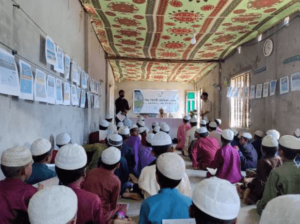
Discussing the current knowledge on migratory shorebird populations at Nijhum Dweep National Park in Bangladesh, with a focus on the EAAFP site at Nijhum Dweep ©️ Jagganath University
Session 2: Discussing the effect of light pollution on migratory birds and solutions to light pollution
Naim Khandakar addressed how light pollution affects migrating birds. Participants learned in this session that light pollution can drastically alter many species’ behaviors such as foraging, activity levels, energy expenditures, and vocal communication. As a result, night-migrating birds such as ducks, geese, sandpipers, songbirds, and plovers are particularly vulnerable to and impacted by light pollution. Artificial light attracts and disorients nocturnally migrating birds. This can cause species to circle illuminated areas, depleting energy, increasing the risk of exhaustion, and increasing the likelihood of predation and fatal collisions with buildings and infrastructure. The link between light pollution and these collisions causes millions of bird deaths each year. Naim Khandakar also addressed how to mitigate the effects of light pollution by reducing blue light emissions by switching to warm-colored light bulbs such as red, yellow, and orange; and updating outdoor lights to ensure they are fully shielded.
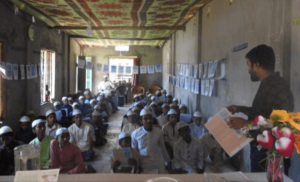
Discussing the effect of light pollution on migratory birds and solutions to light Pollution ©️ Jagganath University
Session 3: Discussing the importance of migratory birds, their habitats, threats to and ecological importance of migratory birds
Participants learned that the country of Bangladesh, offering key wintering and staging sites for thousands of migratory birds. Bangladesh is the last remaining stronghold for non-breeding globally endangered Indian Skimmer, which has been seen annually in Nijhum Dweep National Park on the country’s south-central coast and has been designated as the largest wintering area for this threatened species. Apart from Indian Skimmers, Nijhum Dweep National Park and its surrounding areas are a regular wintering site for many globally threatened migratory wetland species such as Spoon-billed Sandpiper, Nordman’s Greenshank, Spotted Redshank and Aisan Dowitcher. Participants also learned about migratory shorebirds’ habitat preferences for foraging and roosting grounds, threats to, and conservation value of migratory birds. The habitat preferences of Indian Skimmers and Black-tailed Godwits for their roosting and foraging grounds, as published research articles by the Jagannath University Waterbirds Research Team, were presented to participants to broaden their knowledge of migratory Waterbird foraging and roosting habitats.
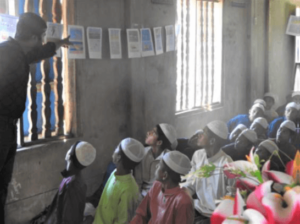
Discussing the importance of migratory birds, their habitats, threats to them, and their ecological importance ©️ Jagganath University
Session 4: Distributing Educational outreach materials to participants and activities
The organizer developed and produced informative educational outreach materials leaflets or one-pagers with information on migratory birds, their flyway, the importance of conserving migratory birds and their habitats, and distributed them to participants to increase their knowledge of migratory birds and their conservation. The organizer also distributed the print poster with the theme of WMBD 2022 in Bengali produced by EAAFP. Following the speech delivery session, students look at printing migratory bird photos hanging on the room’s wall, and memorizing migratory bird species names with facilitator assistance. Then, the students competed in an art competition centered on threatened migratory birds and their habitats.
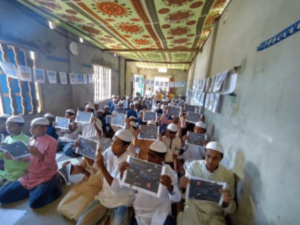
Students displaying printed educational outreach material such as the WMBD poster with the 2022 theme in Bengali produced by EAAFP ©️ Jagganath University
Closing Session
The closing of the WMBD commenced with a summary of the outcomes by Naim Khandakar, followed by closing words from the Headmaster of Bandartila Bazar Government Primary School Md. Bacchu Mia and Principal of Madinatul Ulum Halimiah Madrasah Mufti Illias Hossain. Winners of the Art Competition were rewarded with educational materials wildlife conservation-related books and painting materials from the Headmaster and Principal. The Headmaster and Principal thanked Jagannath University and EAAFP for the successful arrangement of the WMBD events that enriched participants’ understanding of migratory birds, their habitats and improved the protection of migratory birds and their non-breeding grounds at Nijhum Dweep National Park as an EAAFP site for migratory birds.
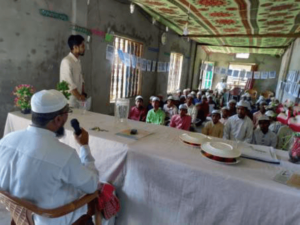
Closing words from Headmaster of Bandartila Bazar Government Primary School Md. Bacchu Mia ©️ Jagganath University
Article by Jagannath University.





